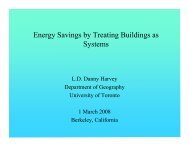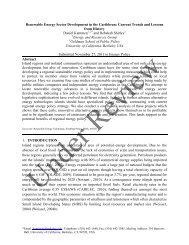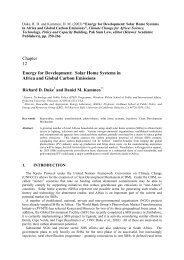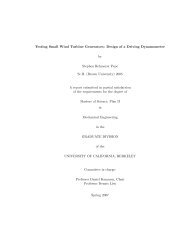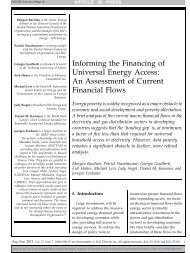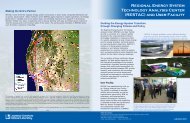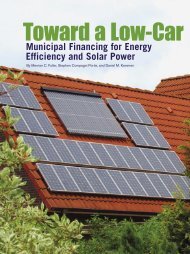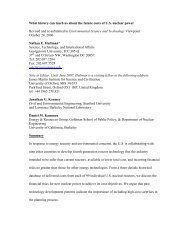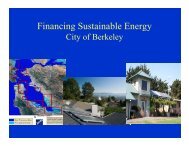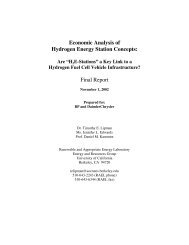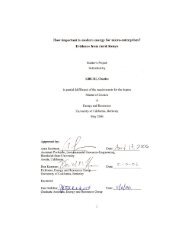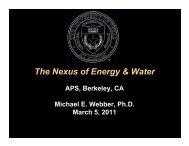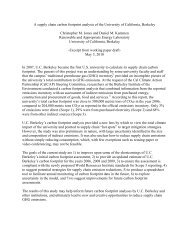IOP PUBLISHINGEnviron. Res. Lett. 8 (2013) 014038 (10pp)ENVIRONMENTAL RESEARCH LETTERSdoi:10.1088/1748-9326/8/1/014038<strong>Deep</strong> <strong>carbon</strong> <strong>reductions</strong> <strong>in</strong> <strong>California</strong><strong>require</strong> <strong>electrification</strong> <strong>and</strong> <strong>in</strong>tegrationacross economic sectorsMax Wei 1 , James H Nelson 2 , Jeffery B Greenblatt 1 , Ana Mileva 2 ,Josiah Johnston 2 , Michael T<strong>in</strong>g 3 , Christopher Yang 4 , Chris Jones 2 ,James E McMahon 1 <strong>and</strong> Daniel M Kammen 2,51 Energy Analysis <strong>and</strong> Environmental Impacts Department, Environmental Energy TechnologiesDivision, Lawrence Berkeley National Laboratory, One Cyclotron Road MS 90R-2002, Berkeley,CA 94720-8136, USA2 Energy <strong>and</strong> Resources Group, 310 Barrows Hall #3050, University of <strong>California</strong>, Berkeley,CA 94720-3050, USA3 Itron Inc., 1111 Broadway, Suite 1800, Oakl<strong>and</strong>, CA 94607, USA4 Institute of Transportation Studies, University of <strong>California</strong>, Davis, CA 95616, USA5 Richard & Rhoda Goldman School of Public Policy, University of <strong>California</strong>, Berkeley, 2607 HearstAvenue, Room 308, Berkeley, CA 94720-7320, USAE-mail: Mwei@lbl.gov <strong>and</strong> kammen@berkeley.eduReceived 31 October 2012Accepted for publication 21 February 2013Published 12 March 2013Onl<strong>in</strong>e at stacks.iop.org/ERL/8/014038AbstractMeet<strong>in</strong>g a greenhouse gas (GHG) reduction target of 80% below 1990 levels <strong>in</strong> the year 2050<strong>require</strong>s detailed long-term plann<strong>in</strong>g due to complexity, <strong>in</strong>ertia, <strong>and</strong> path dependency <strong>in</strong> theenergy system. A detailed <strong>in</strong>vestigation of supply <strong>and</strong> dem<strong>and</strong> alternatives is conducted toassess <strong>require</strong>ments for future <strong>California</strong> energy systems that can meet the 2050 GHG target.Two components are developed here that build novel analytic capacity <strong>and</strong> extend previousstudies: (1) detailed bottom-up projections of energy dem<strong>and</strong> across the build<strong>in</strong>g, <strong>in</strong>dustry <strong>and</strong>transportation sectors; <strong>and</strong> (2) a high-resolution variable renewable resource capacity plann<strong>in</strong>gmodel (SWITCH) that m<strong>in</strong>imizes the cost of electricity while meet<strong>in</strong>g GHG policy goals <strong>in</strong>the 2050 timeframe. Multiple pathways exist to a low-GHG future, all <strong>in</strong>volv<strong>in</strong>g <strong>in</strong>creasedefficiency, <strong>electrification</strong>, <strong>and</strong> a dramatic shift from fossil fuels to low-GHG energy. Theelectricity system is found to have a diverse, cost-effective set of options that meet aggressiveGHG reduction targets. This conclusion holds even with <strong>in</strong>creased dem<strong>and</strong> fromtransportation <strong>and</strong> heat<strong>in</strong>g, but the optimal levels of w<strong>in</strong>d <strong>and</strong> solar deployment depend on thetemporal characteristics of the result<strong>in</strong>g load profile. Long-term policy support is found to be akey miss<strong>in</strong>g element for the successful atta<strong>in</strong>ment of the 2050 GHG target <strong>in</strong> <strong>California</strong>.Keywords: energy system model<strong>in</strong>g, renewable energy, long term energy scenarios,electricity system optimization, deep <strong>carbon</strong> reductionS Onl<strong>in</strong>e supplementary data available from stacks.iop.org/ERL/8/014038/mmediaContent from this work may be used under the terms ofthe Creative Commons Attribution 3.0 licence. Any furtherdistribution of this work must ma<strong>in</strong>ta<strong>in</strong> attribution to the author(s) <strong>and</strong> thetitle of the work, journal citation <strong>and</strong> DOI.1. Achiev<strong>in</strong>g the 2050 GHG target<strong>California</strong> has become an <strong>in</strong>ternationally important testbedfor low-cost, low-GHG energy plann<strong>in</strong>g. <strong>California</strong>’s1748-9326/13/014038+10$33.00 1c○ 2013 IOP Publish<strong>in</strong>g Ltd Pr<strong>in</strong>ted <strong>in</strong> the UK
Environ. Res. Lett. 8 (2013) 014038l<strong>and</strong>mark AB32 law m<strong>and</strong>ates a return of State GHGemissions to the 1990 level by 2020, <strong>and</strong> Executive OrderS-3-05 sets a goal for the State to reduce emissions to 80%below this level by 2050 [1, 2] 6 .In this work, we take an <strong>in</strong>tegrated approach <strong>and</strong> evaluateGHG emissions across the electricity, build<strong>in</strong>g, transportation,<strong>and</strong> <strong>in</strong>dustrial sectors—90% of the current total—<strong>and</strong> donot treat agriculture or non-energy based emissions [3].Tak<strong>in</strong>g the 1990 basel<strong>in</strong>e of energy <strong>and</strong> <strong>in</strong>dustry emissionsas 405 million metric tons CO 2 -equivalent (MtCO 2 -eq), an80% reduction gives a 81 MtCO 2 -eq target for <strong>California</strong> <strong>in</strong>2050 [4]. We take a conservative approach by predom<strong>in</strong>antlyus<strong>in</strong>g technologies that exist <strong>in</strong> the marketplace or are beyondthe demonstration stage.Integrated long-term plann<strong>in</strong>g <strong>and</strong> a portfolio of publicpolicies are be<strong>in</strong>g developed to meet GHG targets <strong>in</strong> <strong>California</strong>.Previous work [5–10] has highlighted the electricitysector as key to deep GHG reduction <strong>in</strong> <strong>California</strong>. This studycomplements <strong>and</strong> exp<strong>and</strong>s on previous work by provid<strong>in</strong>ga detailed, bottom-up assessment of electricity dem<strong>and</strong> <strong>and</strong>supply. Load profiles for <strong>in</strong>creased efficiency, vehicle <strong>electrification</strong>,<strong>and</strong> heat<strong>in</strong>g <strong>electrification</strong> are developed as <strong>in</strong>putsto a state-of-the-art variable renewable resource capacityplann<strong>in</strong>g model of the electric power sector. The SWITCHmodel [11–13] is used to explore generation, transmission,<strong>and</strong> storage deployment through 2050 <strong>in</strong> the synchronouswestern North American electricity grid, of which <strong>California</strong>represents roughly one-third of total dem<strong>and</strong>.We f<strong>in</strong>d that meet<strong>in</strong>g the 2050 GHG target is achievable,but <strong>require</strong>s dramatic changes <strong>in</strong> the way <strong>California</strong> produces,delivers, <strong>and</strong> uses energy. Figure 1 shows the cumulativeimpact of measures that can reach the 2050 target (‘CompliantCase’). Figure 2 shows the radical shift <strong>in</strong> overall primaryenergy result<strong>in</strong>g from these measures. Increased efficiency,low-GHG electricity, <strong>electrification</strong> of heat<strong>in</strong>g <strong>and</strong> vehicles,<strong>and</strong> deployment of susta<strong>in</strong>able biofuels reduce emissions tojust under 100 MtCO 2 -eq <strong>in</strong> 2050 (figure 1). Thus additionalelements are <strong>require</strong>d to meet the 81 MtCO 2 -eq target, suchas higher imports of low-GHG biofuels, higher penetration of<strong>electrification</strong> <strong>in</strong> <strong>in</strong>dustry <strong>and</strong> transportation, or sav<strong>in</strong>gs fromenergy conservation (see onl<strong>in</strong>e supplementary material availableat stacks.iop.org/ERL/8/014038/mmedia). Conservationis highlighted <strong>in</strong> sections 2 <strong>and</strong> 3 as an additional elementto atta<strong>in</strong> the 80% target. The electricity sector model<strong>in</strong>g <strong>in</strong>sections 4 <strong>and</strong> 5 does not <strong>in</strong>clude dem<strong>and</strong> reduction fromconservation s<strong>in</strong>ce there are other pathways to meet the 80%target (e.g., the 100 MtCO 2 -eq case above coupled with higherbiofuel imports). Table 1 provides a summary of energydem<strong>and</strong>s <strong>and</strong> emission <strong>in</strong>tensities for build<strong>in</strong>gs, <strong>in</strong>dustry, <strong>and</strong>transportation sectors for 2011 <strong>and</strong> four 2050 cases.2. Transportation <strong>electrification</strong> <strong>and</strong> biofuels arecriticalManag<strong>in</strong>g transportation sector emissions is vital to achiev<strong>in</strong>gthe long-term GHG target as it makes up approximately 40%6 Detailed <strong>in</strong>formation describ<strong>in</strong>g <strong>California</strong> climate programs can befound at www.arb.ca.gov/cc/cc.htm (Climate Change Programs, <strong>California</strong>Environmental Protection Agency, Air Resources Board).M Wei et alof <strong>California</strong> emissions [9]. As dictated by the current statusof technology, two primary pathways are proposed to achievelow-GHG transportation <strong>and</strong> displace petroleum-based fuels:low-GHG biofuels <strong>and</strong> <strong>electrification</strong> 7 . This work does notconsider hydrogen vehicles due to the multiple challengesposed by hydrogen distribution, storage, fuel cell technology,<strong>and</strong> cost, though under certa<strong>in</strong> circumstances this pathwaycould become another viable, low-GHG option for thetransportation sector.In our analysis, all biomass is directed towards biofuelproduction <strong>and</strong> none is made available for electricity, ow<strong>in</strong>gto the difficulty <strong>in</strong> electrify<strong>in</strong>g some transportation modes<strong>and</strong> the relative abundance of low-GHG sources of electricity.In keep<strong>in</strong>g with the technical potential framework used<strong>in</strong> the build<strong>in</strong>g <strong>and</strong> <strong>in</strong>dustry sectors, we adopt 94 milliondry tons of biomass for an overall supply of 7.5 billiongallons gasol<strong>in</strong>e-equivalent <strong>in</strong> 2050 [6]. This biomass scenarioresults from high growth <strong>in</strong> herbaceous <strong>and</strong> forest residues,improved technical yield recovery, substantial <strong>in</strong>vestment<strong>in</strong> additional energy crops, <strong>and</strong> utilization of ab<strong>and</strong>onedagricultural <strong>and</strong> non-productive forest l<strong>and</strong>s. Consistent withState Executive Order S-06-06, 8 we limit imported biofuels to25% of total supply. Still, total biofuels fall short of projectedliquid fuel dem<strong>and</strong> by 32%, necessitat<strong>in</strong>g a shift to electrictransportation.A stock turnover model is used to project lightdutyelectric vehicle deployment, with 45% of passengervehicle miles from electricity <strong>in</strong> 2050. Passenger vehicle<strong>electrification</strong> assumes that plug-<strong>in</strong> hybrid <strong>and</strong> battery electricvehicles quickly enter the market, <strong>and</strong> by 2050 becomethe majority of the fleet. Vehicle sales adoption curves bydrive tra<strong>in</strong> technology are shown <strong>in</strong> figure S6 (supplementarymaterial available at stacks.iop.org/ERL/8/014038/mmedia),<strong>and</strong> recent State policy targets call for similarly aggressivemarket penetration through 2025 [14]. Fixed, nighttime loadprofiles for electric vehicles are developed as <strong>in</strong>puts for theelectric sector model below. 81 000 GWh of dem<strong>and</strong> areadded to the electric power system <strong>in</strong> 2050 from vehicle<strong>electrification</strong> (figure 1(b)). Aviation, mar<strong>in</strong>e transport, <strong>and</strong>most heavy-duty transport are not electrified due to range<strong>and</strong> weight <strong>require</strong>ments, but other modes, <strong>in</strong>clud<strong>in</strong>g someshort-distance trucks, <strong>in</strong>tra-city buses, <strong>and</strong> rail transport arecompletely electrified.3. Bottom-up build<strong>in</strong>g efficiency <strong>and</strong> <strong>electrification</strong>model<strong>in</strong>gNatural gas currently provides most energy for build<strong>in</strong>g<strong>and</strong> <strong>in</strong>dustry heat, so a major shift <strong>in</strong> State energy policies<strong>and</strong> end-use technologies would be <strong>require</strong>d to enable atransition away from fossil fuel <strong>in</strong> these sectors [15–18].For <strong>in</strong>dustry, low <strong>and</strong> medium temperature processes—39%of <strong>in</strong>dustry fuel dem<strong>and</strong>—are electrified by 2050, total<strong>in</strong>g7 See for example http://gov.ca.gov/news.php?id=17472 (Office of GovernorEdmund G Brown, State of <strong>California</strong>, Executive Order B-16-2012).8 Climate Change Programs, <strong>California</strong> Environmental Protection Agency,<strong>California</strong> Air Resources Board, www.arb.ca.gov/fuels/altfuels/<strong>in</strong>centives/eos0606.pdf. Accessed 1 June 2012.2



